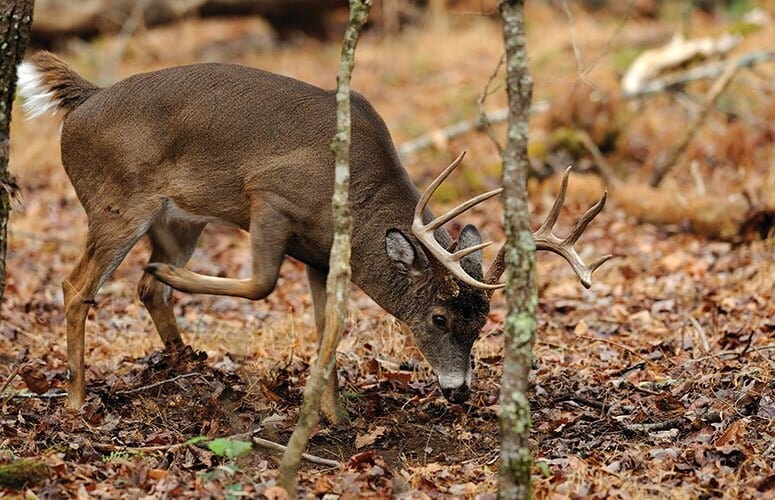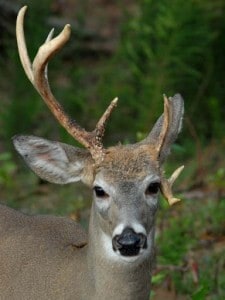There are many misconceptions about deer and deer hunting throughout the country. Everyone believes that one crazy thing that an uncle or grandfather told them, and you probably never thought twice to question it. Don’t worry, after some research, I sadly realized I was also one of these gullible young hunters. Here are five quite popular deer hunting myths and the truth behind them.
1 | Peeing in the Woods
If you’re like me, you probably thought that peeing in the woods was a giant cardinal sin. However, according to research peeing in the woods is absolutely fine and has zero negative effects. All urine is over 90% water, and what is left are things like ammonia, urea, sodium chloride, potassium, and creatinine, along with other inorganic and organic compounds. Deer use these compounds to tell deer and possibly animals apart.
“To deer, humans are predators, so it’s possible that deer can tell the difference between predator and non-predator urine,” said Brian Murphy, biologist and executive director of the Quality Deer Management Association. “But it’s unlikely deer associate human urine with humans, unless a human leaves their scent behind along with the urine.”

After the University of Georgia conducted a test, putting buck urine, human urine, and new car smell in 3 different mock scrapes, they discovered that deer did not treat any of the three differently. They concluded that since the deer find the urine and do not physically see a predator, their curiosity drives them to still investigate the site.
Some hunters even pee in their own mock scrapes. This sounded crazy to me but hey now I don’t need to carry a pee bottle or hold it during all-day hunts.
2 | Scent Control Is Super Complicated
For some hunters, scent control is a challenge. However, if you understand scent control, it can be easy to take care of in just a few steps. Taking care of your scent is a vital part of the hunt and can definitely change the way your hunt goes.
First, you should start off by washing in scent-free soap and drying off with a towel that was also washed in scent-free washing detergent. The natural odors we emit are an immediate red flag to whitetails and you want to limit those as much as possible. You also want to make sure that you wash your hunting clothes in scent-free detergent and before the walk-in, spray your boots, and unwashed items in a scent-free spray.
Then you want to play the wind. Most of the time if you wash yourself and your gear correctly you do not even need to worry about the wind. However, playing the wind certainly would not hurt. Professional hunters have many different stand locations depending on the weather and wind direction. So, if the wind is blowing north on a particular day, try picking a stand that is pointing south.
3 | The Bigger the Rack the Older the Buck
One of the highly debated topics in the deer community is how old a particular buck is. Many times hunters will post a trail cam picture of a buck and ask how old it is. If the buck has a nice set of antlers, hunters generally say it is much older. However, the buck with the biggest rack is not always the oldest.
On the other hand, the buck with the biggest body is often the older buck. When we are trying to tell the age of a buck in the field, we have to look at every physical feature except the antlers. The body of a deer can most of the time tell you exactly how old they are, or at least give you a really good idea.

To estimate the age of a buck by the body, you need a clear broadside picture of the buck. This will let us see every part of the deer we need, unlike a quartering to or away picture.
You then want to look at the neck, belly, and overall body of the deer. A mature buck will have a large neck that looks like it flows right into the body. While young bucks will have a well defined point where the neck stops and the body starts. Secondly, if the belly hangs low, it is likely an older buck. A buck with a smaller or more tucked belly is younger and has not put on his “old man” weight yet.
Lastly, we want to look at the overall body of the buck. What does he look like compared to the average deer in the area? If he is slender and looks like a doe with antlers, then it is a young deer. Although if he looks stocky and bigger than the average deer in the area, he is a mature and older buck.
4 | Only Bucks Contribute To Antler Genetics
While hunters may not literally think does do not contribute to antler genetics, I often laugh when I see hunters say that a certain two-year-old deer should be culled because he has bad antler genetics. Since whitetails often have twins, there could be doe on the same property that has the exact same genetics for antler growth and there is no way you would ever know.

Just because you can cull every spike or deformed buck on the property, does not mean there will not be more next year. Every doe carries antler genetics that they pass along to their offspring. Even if the biggest buck on the property breeds a whitetail, it does not mean that her offspring will be half as impressive as him. On the flip side, an average size or smaller buck could breed a doe with superior antler genetics and make a fawn that will be much bigger than the father.
Another reason you may see a “inferior” buck is because of an injury. It is not uncommon for whitetails to hurt their antlers when they are in velvet. If they do hurt them one way or another, it can cause their antlers to grow in a weird way that year. Although if the injury is not too bad their growth should go back to normal in the following year.
So if you are into deer genetics, you might not want to waste a buck tag on a “management” buck because studies also show that a single organism in a population does not have a large influence on the genetics of the herd as a whole, so there is no need to worry about that deer from a genetics standpoint.
One reason why you may want to harvest that buck is to make room for other deer, and keep that deer from consuming resources on your property. With more resources available, your deer herd will be healthier. Plus a healthier herd means that bucks can grow their antlers to their full genetic potential instead of being limited due to the habitat.
5 | Windy Days Are Terrible for Deer Hunting
We have all been in the stand while our tree sways from side to side with no hope of seeing a deer. While it is difficult to get deer to move during days of high wind, it is not so difficult for us to move.
During super windy days where you think it is useless to sit in a stand, try out a spot and stalk. Spot and stalk is a age old hunting strategy that has been tested time and time again. Plus when it is super windy, it is much easier for you to get away with movement. Since the trees and brush are moving around so much, a deer will likely not notice every minute movement you make.
Plus during a windy day, deer are more likely to stay bedded. This gives you a leg up because it is much easier to stalk a whitetail that is staying put rather than one that is moving around.
Sister Post | 10 Debunked Whitetail Myths
If you liked these myths you are in luck, I have ten more! Check out my other post to discover ten more debunked whitetail myths that you may or may not have heard before.
1 | Whitetail Deer Are Color Blind
You have probably heard the stories of whitetails’ problems with color differentiation. Earlier on, people believed whitetails were color blind and saw everything in black and white shades. However, according to research… Keep Reading
…
4 | Whitetails Never Migrate
The average whitetail spends its entire life inside a square mile. Although when conditions are harsh they need to move on and find reliable food sources. When you consider the distance most whitetails travel when searching for food, this myth might be true if they only cover about 3 miles. However, some of the time, whitetail movements extend to up to… Keep Reading
Thank you for reading my article about deer hunting myths. I hope you enjoyed it and learned something you didn’t already know. If you like my content, subscribe to my weekly update. If you have any other questions about these deer hunting myths or just want to connect, feel free to email me at Patrick.Long@omegaoutdoors.net.
